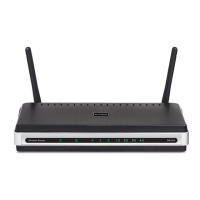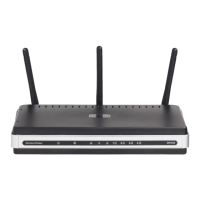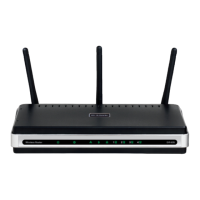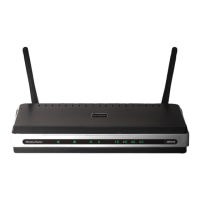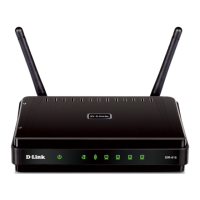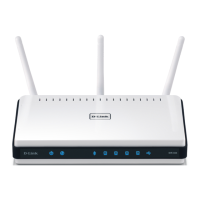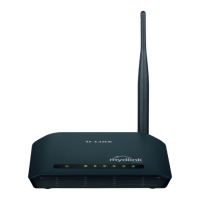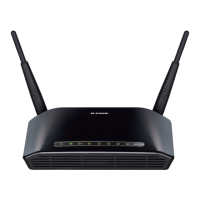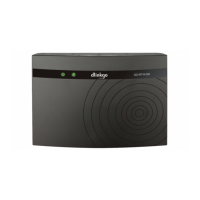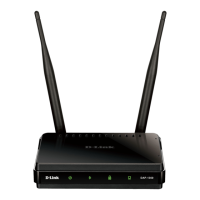Do you have a question about the D-Link RangeBooster N DIR-628 and is the answer not in the manual?
Describes the physical ports on the router for connecting devices and network cables.
Explains the meaning of the status indicator lights on the router's front panel.
Outlines prerequisites and important initial steps before installing the router.
Step-by-step instructions for connecting the router to your internet modem.
Guide for integrating the DIR-628 into an existing network with another router.
Instructions on how to use the Quick Router Setup Wizard for initial configuration.
Explains how to access and navigate the router's web interface for settings.
A guided process to quickly configure the router's essential settings.
Manual setup steps for connecting via dynamic IP (DHCP), commonly used with cable modems.
Manual setup for PPPoE connections, typically used for DSL internet services.
Manual configuration steps for PPTP connections, often used for DSL services.
Manual setup instructions for L2TP connections, another common DSL service type.
Manual configuration for static IP addresses provided directly by your ISP.
Setting the subnet mask for the router's local network.
Activates or deactivates the router's built-in DHCP server.
Defines the pool of IP addresses the DHCP server can assign to clients.
Allows redirecting incoming traffic from one port to another on a server.
Specifies the internal IP address of the device to forward ports to.
Selects the protocol (TCP, UDP, or Both) for port forwarding.
Defines the trigger port used to initiate the application rule.
Activates traffic shaping to prioritize network traffic.
Sets up rules to allow or deny access based on MAC addresses.
Enters a specific MAC address for filtering rules.
Initiates the Access Control Wizard to create new policies.
A guided tool for setting up access restrictions and parental controls.
Allows creation of rules to permit or block specific websites.
Specifies the URLs or domains to be filtered.
Assigns a name to the inbound filter rule.
Activates Stateful Packet Inspection for enhanced security.
Exposes a specific computer to the internet for certain applications.
Specifies the IP address of the computer to be placed in the DMZ.
Specifies the destination IP address for routing rules.
Sets the netmask for the destination IP address in routing rules.
Defines the next hop gateway for the route.
Activates the Wi-Fi Protected Setup (WPS) feature.
Manages PIN configurations for WPS, including generation and reset.
Wizard to help add wireless devices using WPS.
Enables Universal Plug and Play for network compatibility.
Sets or changes the password for the administrator account.
Sets or changes the password for the user account.
Enables configuration of the router via the internet.
Activates sending router logs to an external SysLog server.
Specifies the IP address of the SysLog server.
Activates email alerts for router activity and firmware updates.
Enters the address of the SMTP server for sending emails.
Saves the current router configuration to a file on the computer.
Loads a previously saved configuration file onto the router.
Resets all router settings to their original factory defaults.
Restarts the router to apply changes or resolve issues.
Process for updating the router's firmware for new features or fixes.
Dynamic Domain Name System setup for hosting servers with changing IP addresses.
Performs a ping test to check connectivity to a specified IP address or URL.
Selects the types of log messages to display (e.g., Firewall, System).
Explains the Wi-Fi Protected Access security standard and its improvements over WEP.
Setting the unique name for your wireless network.
Setting a strong password for your wireless network security.
Adds wireless devices using the automatic WPS method.
Adds wireless devices using the PIN method for WPS.
Adds wireless devices using the Push Button Connect method for WPS.
Chooses the WPA encryption mode (Auto, WPA2 Only, WPA Only).
Selects the encryption cipher (TKIP, AES, or both).
Enters the passphrase for WPA-Personal authentication.
Selects WPA-Enterprise mode for advanced wireless security.
Sets the time before client re-authentication is required.
Specifies the IP address of the RADIUS server.
Enters the port number used with the RADIUS server.
Provides the security key for the RADIUS server.
Solutions for issues accessing the router's web interface.
Instructions on how to reset the router password and its implications.
Solutions for issues connecting to specific websites or email services.
Steps to verify the IP address assigned to your network adapter.
Outlines the terms and conditions of the limited warranty provided by D-Link.
Describes the warranty terms for the router's software.
Instructions on how to file a warranty claim with D-Link.
Describes the physical ports on the router for connecting devices and network cables.
Explains the meaning of the status indicator lights on the router's front panel.
Outlines prerequisites and important initial steps before installing the router.
Step-by-step instructions for connecting the router to your internet modem.
Guide for integrating the DIR-628 into an existing network with another router.
Instructions on how to use the Quick Router Setup Wizard for initial configuration.
Explains how to access and navigate the router's web interface for settings.
A guided process to quickly configure the router's essential settings.
Manual setup steps for connecting via dynamic IP (DHCP), commonly used with cable modems.
Manual setup for PPPoE connections, typically used for DSL internet services.
Manual configuration steps for PPTP connections, often used for DSL services.
Manual setup instructions for L2TP connections, another common DSL service type.
Manual configuration for static IP addresses provided directly by your ISP.
Setting the subnet mask for the router's local network.
Activates or deactivates the router's built-in DHCP server.
Defines the pool of IP addresses the DHCP server can assign to clients.
Allows redirecting incoming traffic from one port to another on a server.
Specifies the internal IP address of the device to forward ports to.
Selects the protocol (TCP, UDP, or Both) for port forwarding.
Defines the trigger port used to initiate the application rule.
Activates traffic shaping to prioritize network traffic.
Sets up rules to allow or deny access based on MAC addresses.
Enters a specific MAC address for filtering rules.
Initiates the Access Control Wizard to create new policies.
A guided tool for setting up access restrictions and parental controls.
Allows creation of rules to permit or block specific websites.
Specifies the URLs or domains to be filtered.
Assigns a name to the inbound filter rule.
Activates Stateful Packet Inspection for enhanced security.
Exposes a specific computer to the internet for certain applications.
Specifies the IP address of the computer to be placed in the DMZ.
Specifies the destination IP address for routing rules.
Sets the netmask for the destination IP address in routing rules.
Defines the next hop gateway for the route.
Activates the Wi-Fi Protected Setup (WPS) feature.
Manages PIN configurations for WPS, including generation and reset.
Wizard to help add wireless devices using WPS.
Enables Universal Plug and Play for network compatibility.
Sets or changes the password for the administrator account.
Sets or changes the password for the user account.
Enables configuration of the router via the internet.
Activates sending router logs to an external SysLog server.
Specifies the IP address of the SysLog server.
Activates email alerts for router activity and firmware updates.
Enters the address of the SMTP server for sending emails.
Saves the current router configuration to a file on the computer.
Loads a previously saved configuration file onto the router.
Resets all router settings to their original factory defaults.
Restarts the router to apply changes or resolve issues.
Process for updating the router's firmware for new features or fixes.
Dynamic Domain Name System setup for hosting servers with changing IP addresses.
Performs a ping test to check connectivity to a specified IP address or URL.
Selects the types of log messages to display (e.g., Firewall, System).
Explains the Wi-Fi Protected Access security standard and its improvements over WEP.
Setting the unique name for your wireless network.
Setting a strong password for your wireless network security.
Adds wireless devices using the automatic WPS method.
Adds wireless devices using the PIN method for WPS.
Adds wireless devices using the Push Button Connect method for WPS.
Chooses the WPA encryption mode (Auto, WPA2 Only, WPA Only).
Selects the encryption cipher (TKIP, AES, or both).
Enters the passphrase for WPA-Personal authentication.
Selects WPA-Enterprise mode for advanced wireless security.
Sets the time before client re-authentication is required.
Specifies the IP address of the RADIUS server.
Enters the port number used with the RADIUS server.
Provides the security key for the RADIUS server.
Solutions for issues accessing the router's web interface.
Instructions on how to reset the router password and its implications.
Solutions for issues connecting to specific websites or email services.
Steps to verify the IP address assigned to your network adapter.
Outlines the terms and conditions of the limited warranty provided by D-Link.
Describes the warranty terms for the router's software.
Instructions on how to file a warranty claim with D-Link.
| Frequency Band | 2.4 GHz |
|---|---|
| Max Wireless Speed | 300 Mbps |
| WAN Port | 1 x 10/100 Mbps |
| Wireless Standards | IEEE 802.11n, IEEE 802.11g, IEEE 802.11b |
| Security | WPA, WPA2 |
| Firewall | NAT, SPI |
